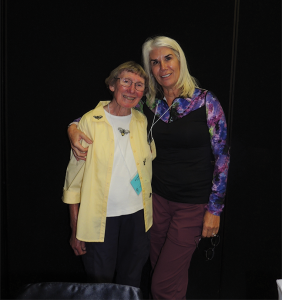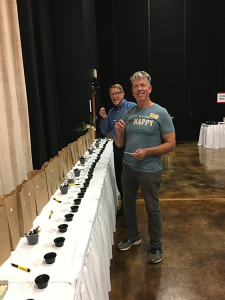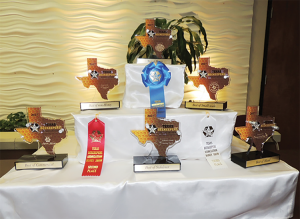Big State, Big Show

Ann Harman
Get it touch
ahworkerb@aol.com
By: Ann Harman
Texas is the largest state of the “lower 48.” Alaska is, of course, the largest of all 50 states. Texas, the Lone Star State, was actually a republic before it became a state in 1845. It is over 700 miles east to west and over 700 north to south. It is big enough to have several distinct climates that provide the plants that the honey bees use.
Interstate highway 35, from Laredo in the south, runs north through San Antonio, Austin (the capital), then Dallas, separating the subtropical eastern part from the arid western part. A few mountain ranges are found in the far west. The panhandle is far enough north to have some snow in winter.
Both Lovell and Pellett described the regions of Texas in their books on honey plants. At the time of their writing Texas was not considered to be a big honey-producing state, except for the area in and around Uvalde County, but was thought to be a good place for raising bees and queens. Nevertheless Texas today has an assortment of excellent honey-crop plants. In 2015 Texas ranked 5th in honey produced.
Texas is well known for its citrus crops, especially the ruby red grapefruit. Oranges and other related citrus plants are also cultivated. However the citrus greening disease did enter the citrus growing area in January 2012. Efforts to control the disease and research into control began immediately after identification. Cotton is grown in areas of the panhandle but its honey is not favored because of rapid crystallization.
In Texas the mesquite tree (also called honey mesquite) produces a rare but very popular and flavorful honey. This honey has been described as being light or light amber and even dark amber. Unfortunately a good honey crop is rare because of unfavorable weather conditions. Rainfall can be unpredictable. The shrubby huajillo produces another famous Texas honey. It is light in color with a mild but rich flavor. The Chinese tallow tree, classed as invasive, does produce copious quantities of very light amber honey with an excellent flavor. This tree is found in the coastal plains of southeast Texas where rainfall is more abundant. Various wildflowers are abundant throughout Texas, contributing pollen for the honey bees and nectar for honey.
So during the years after both Lovell and Pellett dismissed Texas as not having worthwhile honey production, beekeepers began to discover that good honey production was not only possible but that Texas honey varieties were excellent and marketable. Today it is sixth in honey production in the U.S. (Both Lovell and Pellett would have been surprised. They also did not note that huajillo honey from Texas won first prize at the 1900 World Fair held in Paris.)
The Texas Beekeepers Association (TBA) now boasts a membership of 1600 beekeepers, and is increasing membership as more people are discovering the rewards of beekeeping. Texas does have the Africanized bee throughout the state. In fact the first documented invasion of this bee into the United States occurred in southern Texas in 1990. However today Texas has commercial honey producers, as well as sideliners and small-scale beekeepers.
The TBA has a number of activities. Each year the TBA holds an annual conference on a Friday and Saturday in November. The Journal is published six times a year, an issue every other month beginning in January. One important activity is the Texas Honey Queen Program. Each year the Texas Honey Queen competes with others from around the U.S. at the American Beekeeping Federation contest to select a national Honey Queen and Honey Princess. In Texas the Association has also inaugurated the Ambassador and Junior Ambassador program for the male youth beekeepers. Their role, as well as the Queen and Princesses, is to promote honey bees, beekeeping and honey throughout Texas. Texas also has 49 local associations, mostly in the eastern half of the state.

Ann Harman, Senior Judge and Pamela Yeamans, show manager at the 2017 Texas Honey Show.
Cameron Crane photo.
TBA has had a Honey Show in the past. In 2016 most of the entries were in the Black Jar class and in the Photography class. Texas honey was not particularly featured. Little publicity had been given to the Honey Show so it was a minor part of the annual conference.
In about the middle of 2017 a Texas beekeeper wondered why the famous and delicious Texas honeys were not being promoted. Why do the Eastern Apicultural Society (EAS) and the American Beekeeping Federation (ABF) have extensive honey shows with numerous entries?
So this beekeeper, the enthusiastic and energetic Pamela Yeamans of Austin, decided that Texas honeys could be promoted with a well-organized and well-promoted Honey Show at the November TBA conference. It would be a honey show that could encourage the winners to enter the national ABF show. Texas honeys and beekeepers should have recognition.
Pamela then began her search for honey show information by contacting Kim Flottum. The editor of Bee Culture could point her in the right direction for guidance and information. He recommended Ann Harman, a honey show judge and also the organizer of the EAS honey show for a number of years. Pamela also contacted Tim Tucker, a honey judge and Past President of the American Beekeeping Federation.

Clint Walker of Walker Honey Farm, founded in 1930 and Dan Weaver of BeeWeaver since 1880, at the Black Jar People’s Choice Honey Tasting. Pamela Yeamans photo.
Pamela was well-supplied with information: sample score sheets and rules, and many comments about organization, need for volunteers, suggestions for publicity. She wanted to interest not only the backyard beekeepers but also the sideliners and the commercial honey producers. She was fortunate to find someone to design appropriate trophies that reflected the emphasis on Texas. These trophies would also be appropriate for displaying at stands for honey sales.
Since the Black Jar class was the largest class in 2016, it was included in the 2017 show but with several differences. There would be one winner of the class in the show itself. That entry would then be sent to the International Black Jar competition held in North Carolina each year. In addition to the class in the Honey Show, the Black Jar honeys would also have a Public’s Choice competition. The people attending the conference could purchase one ticket for $1.00 and then taste the honeys, each in a small black plastic cup. This year there were 39 entries, again making it a very popular class. The Public’s Choice winner was different from the judged Honey Show class, but that is to be expected since taste is subjective. The money from the Public’s Choice, $189, was donated to the Texas Honey Queen program. Prize-winning honey was auctioned and the other honey entries, along with donations from other classes were sold for a donation to the Texas Honey Queen Program.

2017 Texas Honey Show Awards sponsored by Dadant & Sons, Dancing Bee Winery, Moore Honey, R. Weaver Apiaries, Sabine Creek Honey Farm, Sweet River Honey Company and Walker Honey Farm. Manufactured by Bear Kelley. Jimmie Oakley photo.
In 2017 several classes were added. Creamed honey, beeswax block and beekeeper-invented gadgets had quite a few entries. An Arts and Crafts class was added. Color classes for extracted honey reflected the varietals of Texas: light, light amber, amber and dark. Photography was divided into three classes: Landscape, Portrait and Close-up. Texas is quite proud of their many mead makers. Therefore a mead competition was held with accredited mead judges. Mead classes were Traditional, Spiced, Fruit and Braggot.
Pamela was successful in finding volunteers to help with taking entries, keeping the records, managing the movement of entries and awards and taking photographs that are very important for publicity. Dodie Stillman put in many long hours taking entries and keeping mounds of paper organized. Jimmy Oakley, the photographer, made certain that all aspects of the show were caught on camera. He was also found at the computer, entering all the show information needed for keeping records. Volunteers, such as these, help make a honey show successful.
What has Pamela planned for 2018? You can be certain that the show will be organized, enlarged and even more successful. Texas honeys along with beekeeper’s skills will be featured in November 2018.
Honey Plants of North America. John H. Lovell, The A. I. Root Company, Medina, Ohio. 1926 (facsimile printed by the Root Company)
American Honey Plants. Frank C . Pellett. 1920. Fifth Edition 1976. Edited by Dadant & Sons.
Ann Harman has judged honey all over the U.S. and the world. She makes her home in Flint Hill, Virginia.







